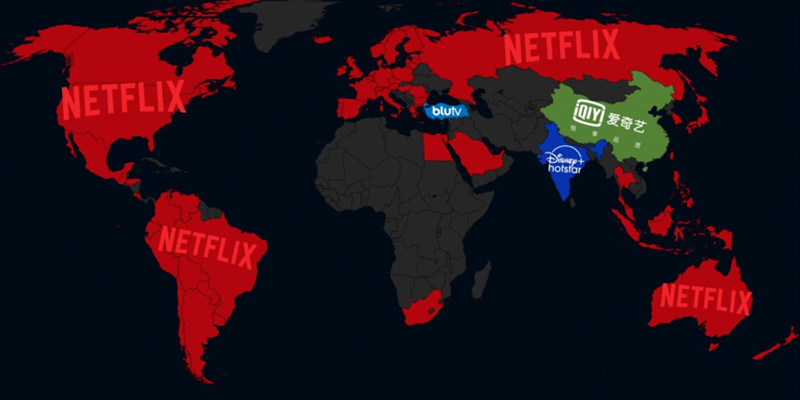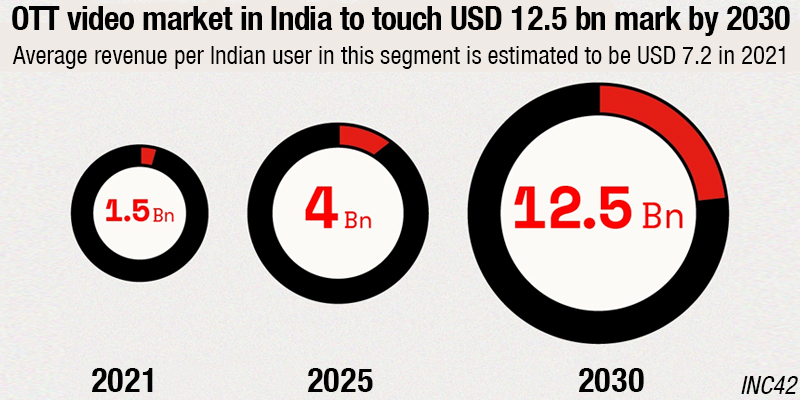BCS Stories
The streaming wars : The future of entertainment

Streaming has had an interesting trajectory. What started out as pure entertainment has evolved into the backbone of several major industries. Businesses that may not have previously placed much emphasis on video streaming found themselves suddenly required to provide smooth, clear, consistent video on par with global streaming media companies from any device. The ability to deliver a great video experience quickly became a strategic business advantage during the lockdown, and this trend will only increase as organizations continue to offer enhanced, innovative experiences through streaming.
To sustain and grow their audience share and reach, streaming providers need to focus on the way that content is delivered to viewers and the quality of the end-to-end service. This quality is now a key differentiator.
Streaming’s growing popularity creates both an opportunity and a challenge for broadcasters and content owners. Firstly, the content market – and therefore the audience that consumes that content – is now more fragmented than ever. The competition is not just found in the market leaders but in other digital arenas like gaming and social media.
The global video streaming market size is expected to grow from USD 419.03 billion in 2021 and reach USD 932.29 billion by 2028, exhibiting a CAGR of 12.1 percent over the six-year period. The growing fondness toward streaming services like Netflix, Hulu, Amazon Prime, and others can have a tremendous impact on the market growth in the forthcoming years, states Fortune Business Insights. The market size stood at USD 376.06 billion in 2020.
The streaming business has benefited from work from home and lockdown during the epidemic. Consumers are adopting media streaming services to spend more time at home entertaining themselves. According to a PWC analysis, viewers’ time spent streaming has grown by 75 percent by 2020. This has fueled demand for new shows, movies, on-demand video games, live news, and other forms of entertainment.
Similarly, throughout the lockdown, the use of video contact with friends and family has skyrocketed. During the pandemic crisis, growing demand across applications such as entertainment, education, social and corporate communication, and information has sped up market growth. Furthermore, the post-pandemic market expansion will be driven by rising advances in 5G technologies and its acceptance and major companies’ ongoing innovation in higher quality content.

Netflix, Hulu, Amazon Prime Video, HBO, and Disney+ are just a few popular streaming services that provide unrestricted real-time access to the high-quality original content. This cutting-edge streaming service has improved the home entertainment experience and increased the company’s client base. Because of its flexible subscription price and device flexibility, many consumers are migrating to the OTT platform. According to Apptopis, when Disney Plus launched its iOS and Android mobile apps in November 2019, it received 3.2 million downloads. Live streaming of news, discussion programs, games, and concerts are becoming increasingly popular as the demand for OTT media entertainment content grows. Various players are partnering with various sports authorities to offer sports material to viewers’ devices, in response to the rising demand for live game streaming. For example, in March 2021, Amazon Web Services, Inc. partnered with the National Football League to stream all football events exclusively. OTT streaming demand is also likely to be fuelled by the impact of pandemic lockdown and quick advances in 5G installation.
Also read, How the OTT landscape is evolving across the globe.
North America has the industry’s largest online streaming industry share because of the huge number of streaming providers in the U.S. Asia Pacific is predicted to be the fastest-growing region during the forecast period. The growing number of tech-savvy people and the rise in smartphone users are two factors driving the Asia Pacific industry forward.
To retain their market position, major companies are constantly working to improve their goods. Strategic alliances, content monetization, and content distribution on multiple mobile platforms have all changed in the streaming sector. Consumers’ growing preference for OTT services and sophisticated feature goods forces businesses to acknowledge the value of live streaming in their operations.
The Indian OTT streaming industry is expected to grow to USD 13-15 billion over the next decade at a CAGR of 22-25 per cent, according to a joint report on media and entertainment from CII and Boston Consulting Group (BCG).
The OTT industry is constantly growing and is one of the most competitive amongst emerging markets with over 40 players representing all types of content providers.
This has been led by “strong tailwinds” from basic enablers being in place for digital video streaming such as affordable high-speed mobile internet, doubling of internet users in the last six years, increased adoption of digital payments.
Moreover, it has been also helped by India specific price points offered by global players here such as Netflix, Prime Video, Disney+ offering plans in India at 70-90 per cent cheaper than the US.
Besides, the OTT sector is also witnessing a rise in investments in Indian original content. This has led to growth in hours of original content available to users.
Indian OTT has progressed from early-stage to scaling stage with transitioned from AVOD to SVOD model, growth in disposable income to drive subscription growth and investing in premium and original content. Now, it will enter into a mass stage, which will witness, Pay-TV cord cutting, high SVOD penetration with consumers subscribing to multiple services and live OTTs. Moreover, the pricing of global streaming services in India has been made affordable to drive adoption.
India’s OTT revenue is estimated to grow from its current level of USD 1.9bn in 2021 to around USD 4.5bn by 2026, said analysts at Media Partners Asia’s APOS India conference, while the total India video market, including pay-TV, will grow to USD 18.2bn over the next five years.
However, among OTT services, advertising video-on-demand will continue to pull in more revenue than subscription video-on-demand, growing from its current rate of USD 1.1bn in 2021 to USD 2.4bn in 2026. Over the same time period, SVOD will grow from its current USD 0.8bn to USD 2.1bn in 2026. India currently has around 102 million SVOD subscribers, which MPA estimates will grow to 224 million by 2026.

The major players in the Indian OTT industry include Netflix, Amazon Prime Video, SonyLIV, Alt Balaji, Zee5 , Eros Now and Disney Hotstar Plus.
Netflix currently leads in terms of SVOD revenue share, with 29 percent of the market, followed by Disney+ Hotstar with 25 percent and Amazon Prime with 22 percent. However, Disney+ Hotstar, which has a much lower subscription price than Netflix, has the largest number of subscribers, accounting for 50 percent of the market, followed by Amazon Prime with 19 percent and Netflix with just 5 percent in volume terms.
Other factors driving growth are India’s young demographics; growing connectivity and lower data costs, spearheaded by telcos such as Reliance Jio; and improved digital payment systems, in particular the government’s Unified Payments Interface (UPI). In addition, around USD 1bn has flowed into Indian-language content for OTT services over the past year.
Indian streaming audiences have become much more open to different kinds of content. “The language barrier has been completely broken,” said Gaurav Gandhi, country head, Amazon Prime Video India. “More than 50 percent of viewership for our regional programming, including Tamil, Telugu and Kannada, is coming from outside of its home state. International and foreign-language content is also being consumed here, as we could see with Parasite last year.”
Netflix India vice president, content, Monika Shergill, agreed that Indian audiences are “ready for experimentation” and noted a 400 percent increase in Korean content viewing, a 100 percent increase in kids programming and a 250 percent increase in non-scripted formats from all over the world.
Both Amazon and Disney+ Hotstar have premiered movies that were made for cinemas but not able to release during the pandemic, while Netflix has been more focused on its own slate of film productions, which were never intended for theatrical.
While India is a mobile-first market, another trend highlighted by several speakers during APOS is the increase in consumers accessing OTT services via connected TVs, which again is a result of the pandemic as viewers were more willing to upgrade their hardware when forced to stay at home.
Aggregation was also flagged as an interesting development with offerings such as Tata Sky Binge, a mobile app with two packages at different price points that aggregates content from 10 OTT services including Disney+ Hotstar, ZEE5, SonyLiv and Eros Now.
The streaming industry has become the top target of cyber attacks. The growth is worrying because these sophisticated attacks can emulate human behavior to evade detection by imitating human keystrokes and mouse movements to trick standard bot-detection tools.
According to the data presented by the Atlas VPN team, 73 percent of attacks directed at the streaming industry were sophisticated. Alarmingly, their data also shows that the stolen credential success rate has risen significantly during login attacks, meaning hackers took away more accounts.
Due to the pandemic, usage of streaming services increased exponentially, meaning that more people became vulnerable to cybercrime as the number of sophisticated cyber attacks increased.
The Indian OTT industry has just started scaling up, and will continue to remain a high volume market. More pricing experiments and bundling of OTT services with the mobile data plans are expected as more global streaming players tap into the Indian market. Advanced technology and user-friendly features can bring random viewers on board. But making the content sticky enough to retain them is what will win the streaming war.








You must be logged in to post a comment Login